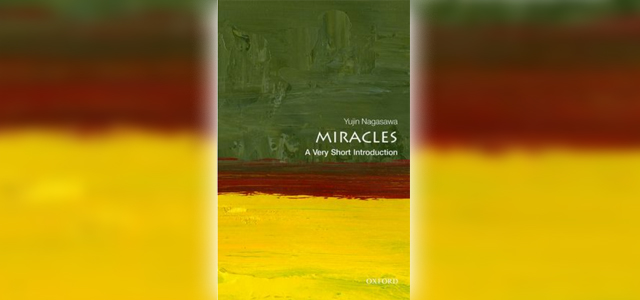Review: Miracles: A Very Short Introduction
Author: Yujin Nagasawa
You may know a miracle when you see one, but they are not so easy enough to define. Or so it seems from this book in Oxford’s ‘A Very Short Introduction’ series.
For a small book, philosopher Yujin Nagasawa spends a lot of pages discussing what is not a miracle. That is because he is carefully winnowing potential cases and moving towards the definition of a miracle as, “a violation of the laws of nature that is caused by an intentional agent and has religious significance.”
That explanation may indicate, correctly, that the book is less a celebration of miracles. Instead, it’s more an attempt to figure out philosophically what miracles are, and, crucially, whether they are possible and why people still believe in them. Nagasawa writes that they are impossible from the standpoint of the laws of nature, but logically possible. Whether they actually happen is a question he leaves somewhat hanging. Perhaps he is reflecting a general consensus in the modern world that we are not sure exactly what to make of them. After-all, one can be religious and reject miracles. Conversely, more Americans believe in miracles than they do in life after death.
It would be almost miraculous to discuss miracles without discussing eighteenth century philosopher David Hume. This philosopher famously made the somewhat circular argument that miracles don’t happen because they can’t happen, though he also sniffily discounted them because they tended to be believed by the lower, uneducated classes. It’s good to be sceptical about miracles. If they happened every five minutes their currency would be devalued. But then again it is no good to suggest that the laws of nature prohibit miracles, because that would be to misunderstand that miracles are by their very nature unnatural.
Miracles can take many forms: levitation, teleportation, bilocation, transfiguration, walking on water, controlling the elements, transforming matter and finding the image of the Virgin Mary on a piece of toast (supposedly). Jesus was known primarily for his miracles of healing and exorcism, as noted by the ancient historian Josephus. But Jesus also warned not to get carried away by signs and wonders. This prompts Nagasawa to go somewhat off-topic again to suggest that what is most remarkable about religion— even if it is not exactly miraculous—is its tendency to inspire altruism.
Nick Mattiske












